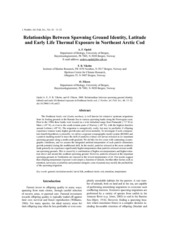| dc.contributor.author | Opdal, Anders Frugård | eng |
| dc.contributor.author | Vikebø, Frode B. | eng |
| dc.contributor.author | Fiksen, Øyvind | eng |
| dc.date.accessioned | 2011-03-16T13:55:49Z | |
| dc.date.available | 2011-03-16T13:55:49Z | |
| dc.date.issued | 2008 | eng |
| dc.Published | Journal of Northwest Atlantic Fishery Science 49: 13-22 | en_US |
| dc.identifier.issn | 0250-6408 | en_US |
| dc.identifier.issn | 1813-1859 | en_US |
| dc.identifier.uri | http://hdl.handle.net/1956/4584 | |
| dc.description.abstract | from its feeding grounds in the Barents Sea to various spawning banks along the Norwegian coast. Prior to the 1990s these banks were located on a wide latitudinal range from Finnmark (~71º N) to Møre (~63º N), or even to the south-western parts of Norway (~60º N), with the highest densities around Lofoten (~69º N). The migration is energetically costly, but may be profitable if offspring experience warmer water, higher growth rates and lower mortality. To investigate if such a temperature- benefit-hypothesis is plausible, we utilize a regional oceanographic model system (ROMS) and a particle tracking model to trace the drift of particles (virtual cod larvae) released at six important spawning grounds along a north-south gradient. We did this for two years with contrasting oceanographic conditions, and we assume the integrated ambient temperature of each particle determines growth potential during the northbound drift. In the model, particles released at the most southerly bank generally do experience significantly higher temperatures than particles released at more northern spawning grounds. This is caused by a combination of higher sea-temperatures and higher retention above and around the southern spawning ground. However, particles released at the important spawning grounds in Vestfjorden are exposed to the lowest temperatures of all. Our results suggest that offspring temperature exposure is not simply a function of latitude, but that other factors such as retention, larval prey availability and potential energetic costs of parents may modify the profitability of the spawning migration. | en_US |
| dc.language.iso | eng | eng |
| dc.publisher | Journal of Northwest Atlantic Fishery Science | en_US |
| dc.rights | Attribution CC BY | eng |
| dc.rights.uri | http://creativecommons.org/licenses/by/2.5/ca/legalcode.en | eng |
| dc.subject | General circulation model | eng |
| dc.subject | Larval fish | eng |
| dc.subject | Northeast Arctic cod | eng |
| dc.subject | Retention | eng |
| dc.subject | Temperature | eng |
| dc.title | Relationships between spawning ground identity, Latitude and early life thermal exposure in Northeast Arctic Cod | en_US |
| dc.type | Peer reviewed | |
| dc.type | Journal article | |
| dc.description.version | publishedVersion | en_US |
| dc.rights.holder | The authors | en_US |
| dc.rights.holder | Copyright 2008 the authors. Published under the Creative Commons Attribution-Non Commercial 2.5 Canada Licence. | en_US |
| dc.identifier.doi | https://doi.org/10.2960/j.v41.m621 | |
| dc.subject.nsi | VDP::Mathematics and natural science: 400::Zoology and botany: 480::Marine biology: 497 | en_US |

